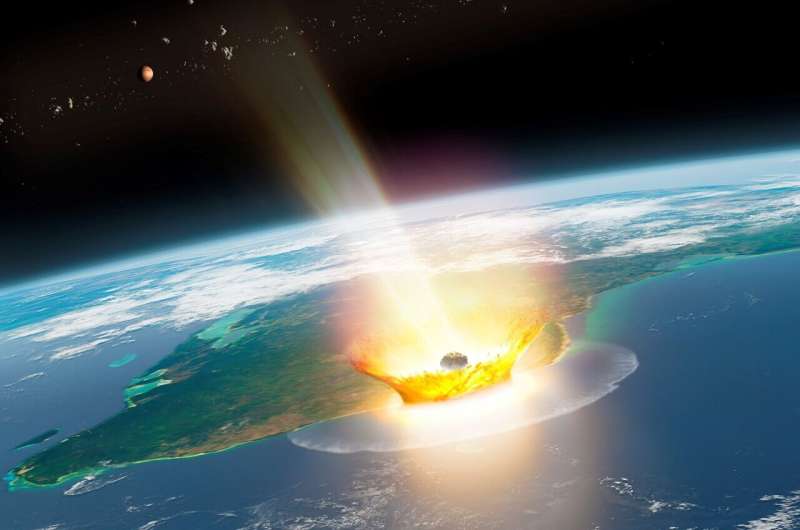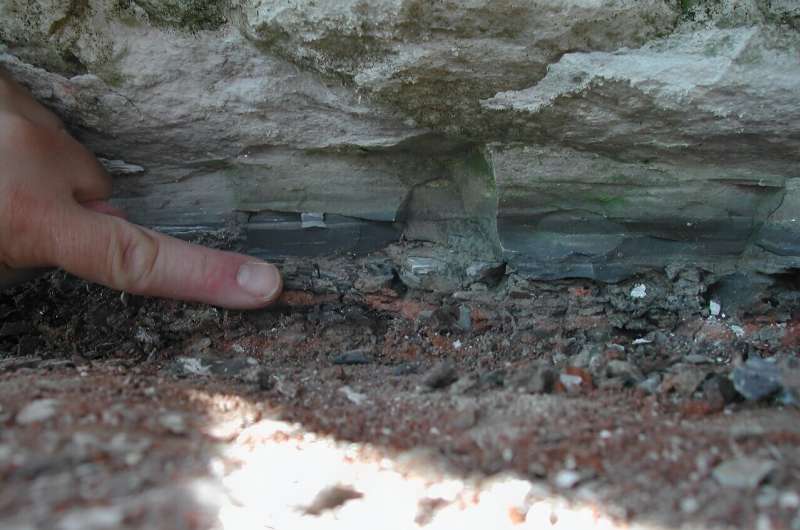
Artist’s impression of a massive asteroid hitting Earth, like the Sixcule event that caused the end-Cretaceous mass extinction, 66 million years ago. Illustration shows an asteroid impact on Chicxulub. Mars and asteroid bodies are shown in the background. Credit: Illustration by Mark Garlick
An intense debate surrounding the cosmic rock that killed the dinosaurs has roiled scientists for decades, but a new study has revealed some important—and far-reaching—data about the impact’s origin story.
The researchers, whose findings were published Thursday in the journal Scienceused an innovative technique to demonstrate that the culprit of the most recent mass extinction, which crashed into Earth’s surface 66 million years ago, originated beyond Jupiter’s orbit.
They also reject the idea that it is a comet.
New insights into the apparent asteroid that cratered Chicxulub in present-day Mexico’s Yucatan Peninsula may improve understanding of the celestial objects that hit our planet.
“Now we can say with this knowledge… that this asteroid initially formed beyond Jupiter,” lead author of the study and geochemist Mario Fischer-Gott of the University of Cologne told AFP.
The results are particularly remarkable considering how rarely this type of asteroid collides with Earth.
Such information could be useful in assessing future threats or determining how water came to be on the planet, Fischer-Kott said.

This undated handout image shows a 66-million-year-old Cretaceous-Paleogene boundary layer in Stevens Klint, Denmark, which contains debris from an asteroid impact in present-day Chicxulub, Mexico.
Samples
The new findings are based on an analysis of sediment samples formed between the Cretaceous and Paleogene eras, the time of the catastrophic asteroid impact.
The researchers measured isotopes of the element ruthenium, which is not uncommon in asteroids but is extremely rare on Earth. So by examining deposits in several geological layers representing impact debris at Chicxulub, they could be certain that the ruthenium studied came “100 percent from this asteroid.”
“Our lab in Cologne is one of the rare labs that can make these measurements,” Fischer-Kott said, “and it’s the first time such inspection techniques have been applied to impact debris layers.”
Ruthenium isotopes can be used to distinguish between two main groups of asteroids: C-type, or carbonaceous, asteroids that formed in the outer Solar System and S-type silicate asteroids from the inner Solar System near the Sun.
The asteroid that triggered a mega-earthquake, triggered a global winter and wiped out the dinosaurs and other species was a C-type asteroid that formed beyond Jupiter, the study confirms.
Studies from two decades ago had already made such an assumption, but with much less certainty.
The results are surprising, Fischer-Kott pointed out, because most meteorites — fragments of asteroids that fall to Earth — are S-types.
So did the Sixthum impact beyond Jupiter make a beeline for our planet? Not necessarily.
“We can’t say for sure where the asteroid was hiding just before the impact with Earth,” Fischer-Cote said, adding that after it formed, it may have stopped in the asteroid belt that lies between Mars and Jupiter. Most meteorites form.
Not a comet
The study also rejects the idea that the destructive impact was a comet, a mixture of icy rocks from the edge of the solar system. Such a hypothesis was presented in a highly publicized 2021 study based on statistical simulations.
Model analyzes now show that the celestial material is very different in composition from the subset of meteorites believed to have been comets in the past. So the impact in question is unlikely to have been a comet, Fischer-Kott said.
As for the wider applicability of his findings, the geochemist made two recommendations.
He believes that more precisely defining the nature of the asteroids that hit Earth about 4.5 billion years ago will help solve the puzzle of the origin of our planet’s water.
Scientists believe water may have been brought to Earth by C-type asteroids like the one that hit 66 million years ago.
Studying past asteroids allows humanity to prepare for the future, Fischer-Kott said.
“If we find that previous mass extinction events can be associated with C-type asteroid impacts, we should be very careful if there is ever going to be a C-type asteroid in an orbit that crosses Earth,” he said. “Because we may be the last witnesses,” he said.
More information:
Mario Fischer-Gödde et al, ruthenium isotopes show that the Sixula impactor is a carbonaceous asteroid, Science (2024) DOI: 10.1126/science.adk4868
© 2024 AFP
Quotation: Scientists discover dino-killing asteroid: Last Thursday (2024, August 16) Retrieved August 16, 2024, from https://phys.org/news/2024-08-scientists-dino-asteroid-jupiter.html
This document is subject to copyright. No part may be reproduced without written permission except for any reasonable manipulation for personal study or research purposes. Content is provided for informational purposes only.

